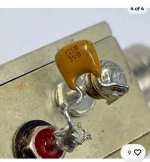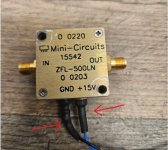I've been looking at Mini-Circuits recently and would like to start experimenting with some. I have a few questions about the following three pictures:
Thanks



- Question 1: Picture 1 has a USB type C connector. Is this a valid way to permanently power an indoor-only device? What would be a good alternative if it were outside and the bias T route was not available?
- Question 2: Picture 1 and 3 have really nice connections to the V+ and GND terminals. Is that just heat shrink? Or some other material?
- Question 3: In Picture 2, there appears to be a ?capacitor? between the V+ and GND terminals. What is the purpose of this? I've noticed it being used in many online used listings.
- Question 4: What gauge wire would you recommend using for 5v? I have various amounts lying around.
- Question 5: I noticed that in a few of the datasheets that I read, there is a very narrow window for voltage changes without destroying the internal components. If I go the USB type C route, how can I best prevent the variable output besides using high quality name brand power bricks?
Thanks




